
A few weeks ago I went along to the biennial RAAF Museum Pageant. The RAAF is, of course, the Royal Australian Air Force, and the RAAF Museum is at Point Cook, on the outskirts of Melbourne. Despite being relatively nearby I’ve never been, so when fellow aviation blogger JDK (who volunteers at the Museum) suggested the Pageant would be worth going along to I took his advice. And it was good advice too!
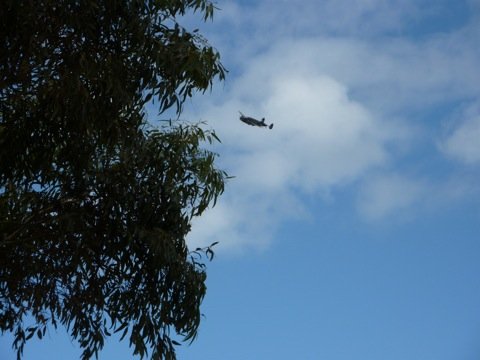
The Pageant is an air show, and it would have been a good idea if I’d got there in time to see the whole flying display. But on the long trudge (buses? in the outer suburbs? whatever for?) from the aptly-named Aircraft railway station (not apt because of Point Cook but because of another RAAF base, Laverton) I did at least manage to glimpse some of the earlier flights (such as this Lockheed Hudson — on which, more below).
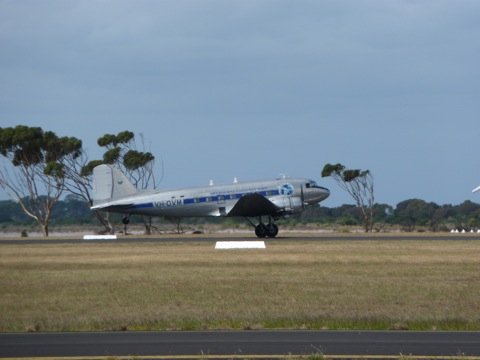
This Douglas DC-3 is a familiar sight in Melbourne skies, as it is used for scenic flights. Something it apparently couldn’t do if it were in the UK since it would be too difficult to comply with safety regulations. Their loss, our gain.
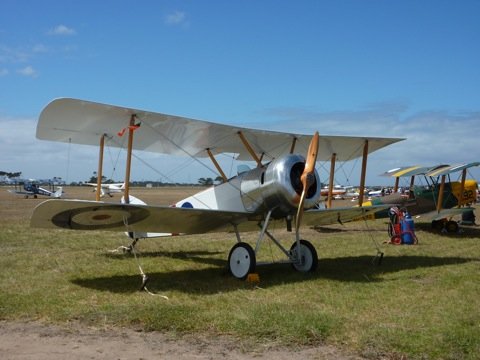
The Museum’s flying replica Sopwith Pup.
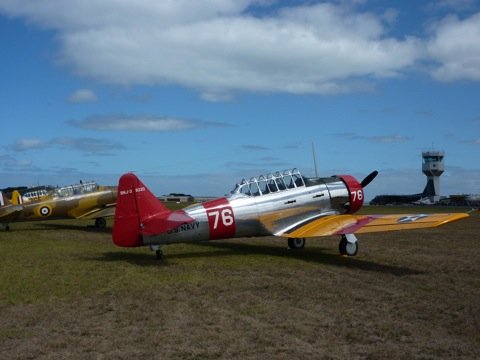
Some North American Harvards, a long way from North America!

The Hudson on the ground. It’s the largest Second World War bomber still flying in Australia.

The Hudson’s turret. Thanks to JDK, I was able to sit in the driver’s seat. The Hudson was effectively a militarised variant of the Lockheed Super Electra, a civilian airliner. As such it should have been a very capable bomber, if those who worried about convertibility were to be believed. But it wasn’t, particularly (whacking a great big turret on it probably didn’t help its aerodynamic qualities). Having said that, they had their uses: a RAAF Hudson was the first Allied aircraft to strike back at the Japanese in 1941, setting a troopship on fire off Malaya an hour before Pearl Harbor was attacked.

A familiar shape. It’s a Supermarine Spitfire Mk VIII which belongs to the Temora Aviation Museum.

I found that my camera wasn’t really up to the job of shooting the flying display. I’d just about gotten away with it at Old Warden, but here the aeroplanes tended to be further away (so harder to find without a viewfinder) and faster (so difficult to capture when they were close). So most of the flying pics I have are sadly uninspired.

A Curtiss P-40 Kittyhawk. Much of it spent nearly half a century as a wreck on Vanuatu before being restored to flightworthy status.

This is not a North American F-86 Sabre leading a North American P-51 Mustang and a Spitfire; it’s a CAC Sabre leading a CAC Mustang and a Spitfire. The Commonwealth Aircraft Corporation, an Australian aircraft company, built Australian versions of both the Sabre and the Mustang. The Sabre was only restored to flying condition last September, the only flightworthy example of the Australian version still around.
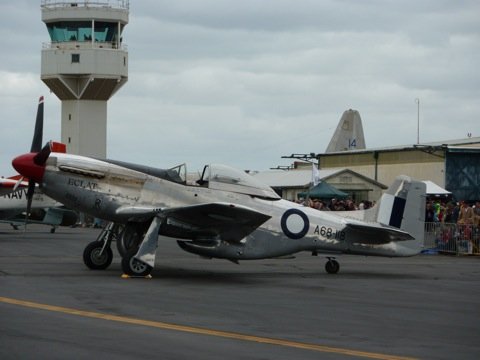
Another CAC Mustang, this one privately-owned.

This Pilatus PC-21 gave the most impressive aerobatic display of the day. A very powerful little machine.

A new-build Yakolev Yak-9.
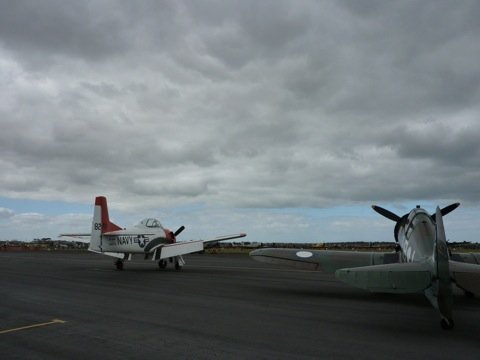
Yet another North American machine, a T-28 Trojan, alongside yet another CAC machine, a Boomerang.

The Mk IX taxiing. The shark’s teeth nose art is rare, but historical: No. 457 Squadron RAAF, the ‘Grey Nurse Squadron’, flew its Spitfires looking like this in the later stages of the war against Japan.

The Roulettes, the RAAF’s precision flying team, doing their thing. They’re flying Pilatus PC-9s, the RAAF’s basic trainer.
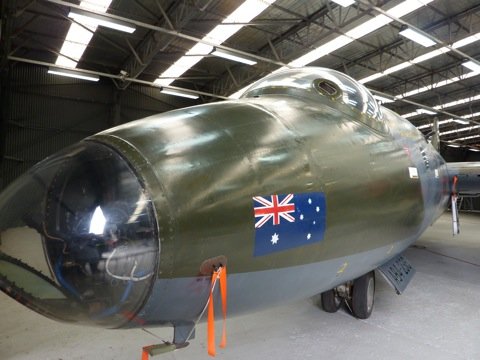
Visitors to the Pageant got to see a preview of the Museum’s new Strike Hanger, which will showcase the RAF’s postwar bomberstrike aircraft.

Here is a GAF Canberra. GAF was the (Australian) Government Aircraft Factory at Fisherman’s Bend in Melbourne, and its variant of the Canberra had extra fuel tanks to extend its range. RAAF Canberras saw action in the Malayan Emergency and Vietnam.
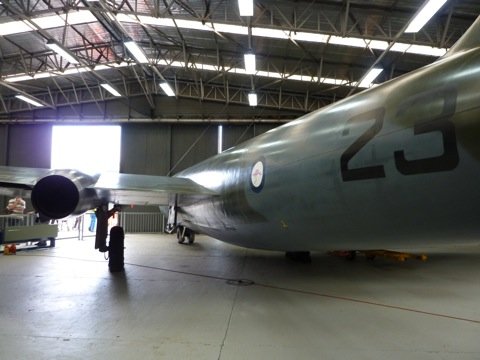
Apparently the name was chosen because Australia was the first export customer, but the British had a somewhat odd habit of naming their bombers after provincial and imperial towns and cities; I think the Canberra was the last example of that.

But despite the name, the RAAF stopped using Canberras in 1982; the RAF kept them on until 2006, 57 years after its first flight!

The Canberra’s successor in the strike role was the McDonnell Douglas F-4 Phantom II. The RAAF only had them for a few years in the early 1970s, leasing them while waiting for the F-111 to come along. (The same thing is happening now that the F-111s are being retired: the Joint Strike Fighter won’t be ready for a while, so the RAAF is leasing some Super Hornets in the interim. Both the F-111 and, more or less, the JSF were ordered before they even flew.)

The Phantom’s appendix. All Phantoms have folding wings, a vestige of its original design as a carrier-borne fighter which has not much use on land.
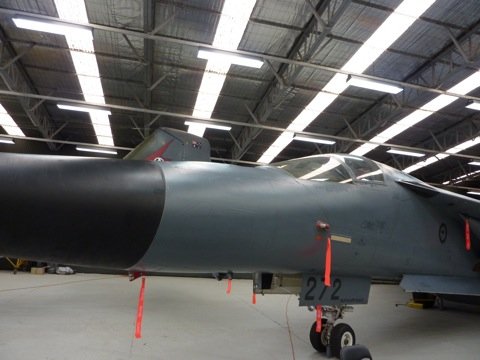
The aforementioned General Dynamics F-111.

AKA the Pig.

The F-111 is being retired from the RAAF’s inventory this year, which makes it a suitable museum piece.

F-111s never saw combat in Australian service (although I suppose there is still time!) But they were used to spy on a Tasmanian dam project in 1983 and to sink a North Korean freighter in 2006.

Inside the bomb bay are the signatures of the last groundcrew to service the aircraft.

A last shot, of the Kittyhawk.
There was a lot more to see, and indeed I was back a week later when all the crowds had gone! More on that in another post.
![]() This work is licensed under a Creative Commons Attribution-NonCommercial-NoDerivatives 4.0 International License.
Permissions beyond the scope of this license may be available at http://airminded.org/copyright/.
This work is licensed under a Creative Commons Attribution-NonCommercial-NoDerivatives 4.0 International License.
Permissions beyond the scope of this license may be available at http://airminded.org/copyright/.


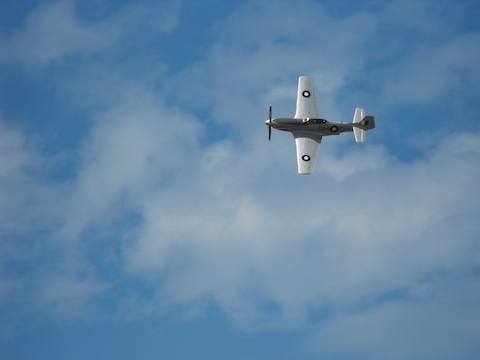

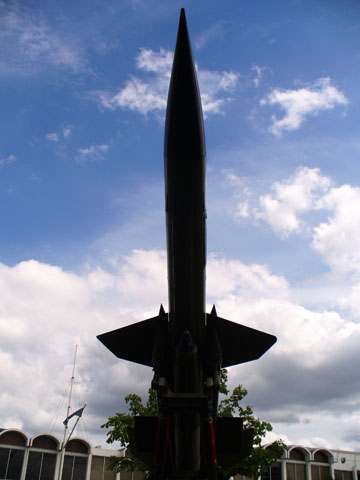

Good post, Brett!
I see me in the Boulton Paul turret there…
To add a bit, thanks for the Hudson insight should really go to Temora for bringing it and to Doug Hamilton, the pilot, who kindly gave us permission to board – I was just liaison. But I was going to get Brett on board a bomber somehow.
The Hudson wasn’t a bad bomber, the list of Hudson achievements bears investigation (as well as your point, an RAAF example’s pilot and gunner downed a Zero or two in running combat before succumbing, while an RAF one shot down a Dornier Do 18 on maritime patrol – the first British operated aircraft victory of W.W.II – and they notched up a few U Boats, which was the RAF Hudsons job). As the best we had at the time, and facing superior enemy forces, we should tip the hat to the chaps who achieved what they did with it. Certainly they were better than the (previous generation) Avro Ansons.
As well as the RAAF’s CAC Sabre being a unique flyer, Judy Pay’s P-40 (actually a p-40F) is the only airworthy Merlin example anywhere in the world, while the Hudson is the only airworthy example worldwide as well – Merlin P-40s and Hudsons are also rare in toto with only a handful surviving of both kinds. There are only two Spitfire VIIIs flying – both ex-RAAF examples, the other having just been sold from the UK to Germany. Yes, really.
The story goes that the name ‘Canberra’ was a ‘fishing’ name to hook Menzies for an order – and it worked. (Dunno, too modern for me.) We are still awaiting the Miles Melbourne, although those ought to float, rather than just bomb – Bombers were supposed to be cities, flying boats port cities, so the Saro London was a flying boat, and there was the prospective Blackburn R.B.2 Sydney… So other bombers would be the Westland Wagga Wagga or the Reid and Sigrist Toowoomba.
Enough from me, Nurse is calling…
The Tasmania story is crazy.
The Hudsons were the first fruit of the RAF’s big American buy. The Allied purchasing commission went over to look at American planes in 1938, and the only ones the RAF wanted then were the Super Electra/Hudson and the Harvard. The French, on the other hand, were much more liberal and bought everything in sight. Not only did they have more to buy, they had more mad money in their dollar account. Together, the Allies pumped almost 2 billion dollars into the American economy, going a fair ways to counteract the Administration’s withdrawal of stimulus spending and helping to prove Keynes right one more time. The answer to depressions is war.
As for why the RAF wanted the Hudson, it did go to further expand Coastal Command, since shipowners (who swung many backbench and not-so-backbench votes — why is Archibald Hurd coming to mind?) were getting very uptight about German naval expansion, but the bomber boys had an angle. It was also supposed to be a navigational trainer. The big cabin meant a nice flying classroom that you could pack with trainees who could take turns doing star shots and such out the big turret.
Now I just have to find a source to support my hazy memories of this….
“Sir, what’s that at 080?”
“Can’t you make out the distinctively angled empennage? That is undoubtedly a Handley-Page Albury-Wodonga, powered by quintuple abnormally-aspirated Bristol Brontosaurus radials.”
PS – wherefore the Napier Knuckleduster (a v4 two-stroke 50cc sleeve valve engine designed to power folding paratroopers’ motorbikes), the Rolls-Royce Roc (the H48 version of the Vulture) or the Wright Vortex Compound-Turbo (in which a picture of some cylinders was stenciled onto the sides of an Allison T56)?
Bill Gunston’s life of Bristol engine designer Roy Fedden has this bizarre passage where he repeats Fedden’s “it’s not what it seems” story from the time his wife caught him in action with his secretary in a bedroom behind his office.
Now there’s a guy who knew abnormal aspiration. I wonder if he had a brontosaurus?
….
Sorry, perils of coming here direct from the latest Order of the Stick update:
http://www.giantitp.com/comics/oots0710.html
Not that that explains anything to anyone who isn’t already following the strip.
They could have been a bit more imaginative about it, though: the Blackburn Wedderburn or the Bristol Bristol.
And, having been inside a Hudson, I can say with authoritatively that it’s only relatively roomy inside!
There was a Blackburn Blackburn. It’s in the Ugliest Aircraft thread, IIRC.
The Blackburn Blackburd [sic]. It’s true that British aeroplanes in WWI had some nicely whimsical names, some of which have been hallowed through familiarity (‘Camel’ isn’t all that martial, for example. And ‘1½ Strutter’ might have sown confusion in the ranks of the enemy, but not fear.). For that matter I think there were those who protested at the name given in 1935 to Supermarine’s new fast all-metal mono fighter …
No, really:
http://en.wikipedia.org/wiki/Blackburn_Blackburn
Although to be fair, the Avro Bison, built to the same spec (“You know that some of you are beginning to call the cockpit ‘the office’? Well what we need here is an _actual_ office. In an carrier plane. Next month.”) was even more ugly:
http://en.wikipedia.org/wiki/Avro_Bison
I stand corrected and humbled!
It’s important* to differentiate between nicknames and formally given names: nicknames were (and are) generally pretty explicable and unmartial, while given names (often) defy anything but bureaucratic system explanations. There’s a book – Names with Wings which covers the British (and Commonwealth) system, IIRC.
Nicknames – Taking Sopwith, the 1&1/2 Strutter after its unusual cabine strut arrangement, Pup, after ‘son of the 1&1/2 Strutter’ and Camel as ‘the one with the hump’ (over the guns). Dolphin and Salamander were, I think formal names, as was, I think, Tabloid.
It’s a fun game to play exceptions and oddities with, and the Blackburn Blackburn is the only repetition I’m aware of – The Westland Westland and Gloster Gloster being opportunities missed – and regions, not towns…
*In a very ‘not important’ thing kind of way…
Pingback: Airminded · RAAF Museum 2